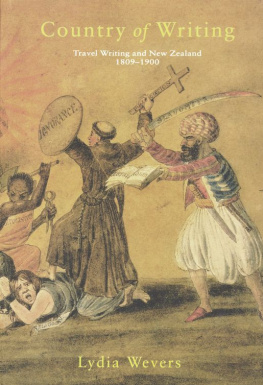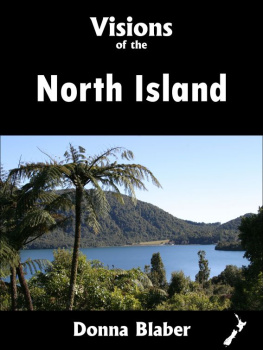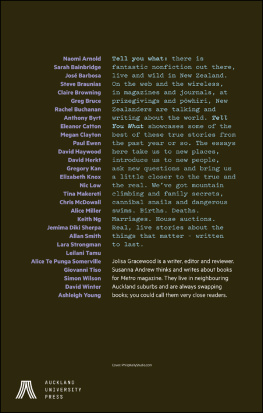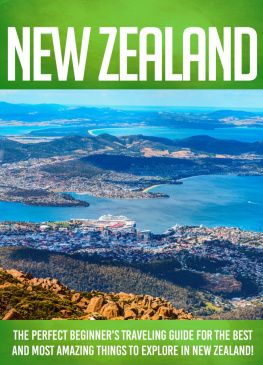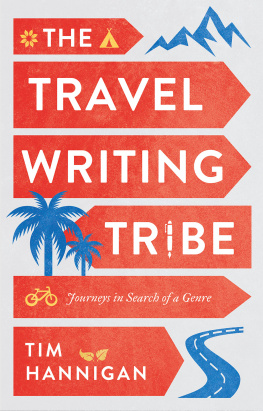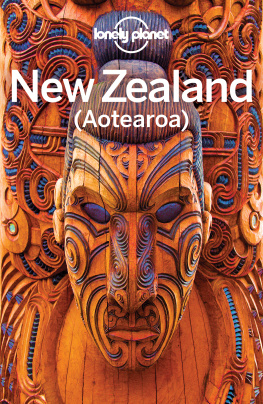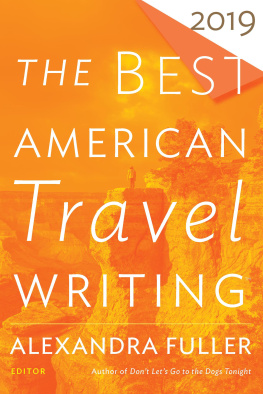This book would not have been attempted without the generous help of the Marsden Fund, which gave me a three-year research grant as part of the History of Print Culture Project, hosted by the Alexander Turnbull Library and the Humanities Society of New Zealand ( HUMANZ ). Initial work on the book was done with the aid of a non-fiction grant from Creative New Zealand or the Arts Council of New Zealand, as it then was, in 1995.
I owe immense thanks to the staff of the Alexander Turnbull Library and the National Library of New Zealand, who put up with my exorbitant requests for materials, a perpetual and overladen trolley, listened to chapters as they were drafted and were personally as well as professionally helpful. In particular, I would like to thank Marian Minson, Barbara Brownlie, the staff of the ATL research centre, Joan McCracken, Di Woods, Susan Bartel, Heather Mathie and David Retter.
My colleagues in the History of Print Culture Project Brian Opie, Penny Griffith, Sydney Shep, John Thomson, Philip Rainer, Margaret Calder, Kathleen Coleridge, Ross Somerville and Stephen Hamilton have been encouraging and helpful. I especially want to thank Penny Griffith, project manager, for her endless hours of help, and Brian Opie, whose innovativeness and determination made the project happen.
I am very grateful to Phil Parkinson for generously sharing his enormous original research with me. Many other people have been helpful and interested: Malcolm McKinnon, Ian Willison, Elizabeth Webby, the late D.F. McKenzie, Justine Clark, Vincent OSullivan, Mark Williams, Roger Blackley, Laura Kroetsch, Lyman Sargent, Jane Stafford, Linda Hardy, John Newton, colleagues at the Stout Research Centre. This book is immensely improved by the many hours of patient and scrupulous attention paid to the manuscript by Andrew Mason, whose editing skills are unrivalled. I would also like to thank Elizabeth Caffin and Katrina Duncan of AUP for their hard work on the text, and Ginny Sullivan for a very fast and good job on the index. My family, Alastair Bisley, Seb, Lizzie and Tom, have been wonderful.
The most dramatic way in which the force of the encounter between Europeans and non-European peoples all over the world can be brought home to us two centuries later is via the print record. Simply as an illustration of the tidal wave that overtook an oral culture, collections of nineteenth-century writing about New Zealand travel books, maps, emigration guides, ethnographies, newspapers , periodicals, shipping brochures, shipboard newspapers, journals, logs are overwhelming in quantity and range. Print was the medium of permanent change, and Maori recognised the attraction of print and the power of literacy almost as soon as they encountered it. CountryofWriting surveys a particular tranche of print history books which fall into the broad category of travel writing, itself composed of many different kinds of writing to show what is transmitted to us by bookish travellers.
A community shapes and formulates its most fundamental experiences by deciphering the many texts it receives, produces and makes its own. This observation by the French historian Roger Chartier about the work of the New Zealand bibliographer D. F. McKenzie neatly summarises a set of relationships and effects that CountryofWriting attempts to elucidate. By investigating the accumulation of texts about New Zealand which were produced and received by travellers, an idea of how the most fundamental experiences were shaped and formulated reveals the constant play of projection and reflection, of cultural tension and anxiety, that both produces and characterises books by travellers, suggesting something about why travellers write books as well as the forcefulness of a print-based culture.
Benedict Anderson has characterised a dimension of European imperialism as print-capitalism. phrase out from its reference to the book trade to suggest what CountryofWriting makes evident. The many fronts on which travel writing facilitates an intersection between a distant culture and a present enterprise, and the ways in which those intersections illustrate pressure points, assumptions and attitudes, are a constant theme of CountryofWriting. As well as articulating and reinforcing a set of obvious comparisons between the travellers culture and the place of travel based on ideas about civilised and savage peoples, waste and overpopulated landscapes, degenerating and invigorating climates, and what constituted natural beauty, travel books are expressions of the effectiveness of print in putting the world on show and delineating a geography of power. There is a very long time-lag between nineteenth-century descriptions of non-European worlds and the Empires reply, and for at least a hundred years the traffic in books, knowledge and people flowed out from Europe and not towards it.
The colour blue
In a paper delivered to the Hawkes Bay Philosophical Institute in the 1880s, William Colenso described one of the striking effects produced by the arrival of Europeans in the Bay of Islands. He claimed that Maori had few natural materials with which to produce the colour blue. In the early summer young Maori would decorate their faces with light-blue fuchsia pollen, or use pukeko feathers and berries, but blue was a rare element of their palette until the arrival of Europeans, after which no colour was better known to them in all its shades than this one of blue. Sailors wore blue jackets, blue shirts, blue trousers and blue caps; in the mission houses children wore navy blue cotton printed with tiny white dots, women wore blue linen and men blue woollen or striped cotton shirts and sometimes blue caps. It was a neat sight to see the children and adult women sitting together at school clad in decent garments of English blue. After the arrival of the American whalers there were twilled cotton shirts with a wider blue stripe and the famed American blue twilled cotton, which washed to a dull greyish-blue colour and was known by the Maori as tupapaku (corpse).
One of the delights of reading travel writing is the discovery of details about the past. Colensos recollections of the clothing worn in the Bay of Islands in the 1830s, including pre-Treaty denim, brings the whole scene into colour and focus as we look back to the visual impressions of a devout young printer recently arrived on the other side of the world. But Colensos description is not travel writing as it is practised in the twenty-first century. His papers delivered to the Hawkes Bay Philosophical Institute and collected in the TransactionsoftheNewZealandInstitute were scientific, reflecting his continuing concern to describe and classify the world he arrived in fifty years before, and to preserve Maori
Writing produced by travel followed precedents and protocols mostly to do with the transmission of geographic, ethnographic and environmental knowledge back to the sorting-house of Europe. New Zealands extreme distance from Europe, literally the furthest away you could go, also conferred on it a special character: New Zealand as a wonderland of the new, a terraincognita of tremendous possibilities, was part of the response of travellers from the beginning. At the same time travel writing involved the author in what Mary Louise Pratt described as the anti-conquest: writing which represented travellers, explorers and naturalists as innocent investigators, motivated by their pursuit of knowledge , whose journeys happened to occur at the historical moment of European dispossession and appropriation. For example, Colensos recollections of the post-contact community of the Bay of Islands dressed in blue give a chromatic cohesion and a peaceful flavour to the scene of colonisation; many of his efforts to preserve Maori knowledge occurred after war, land confiscations, dispossession and depopulation. These effects of European expansion are excluded from or diminished in most travel writing, which focuses instead on its innocent task of observation and the transmission of knowledge.

